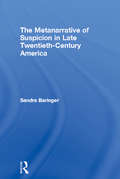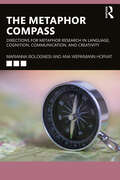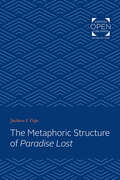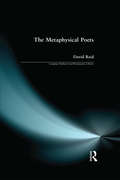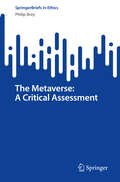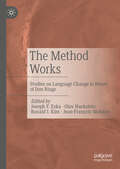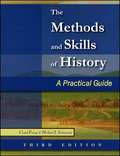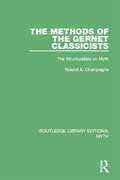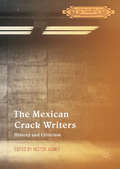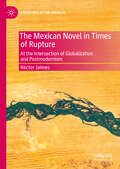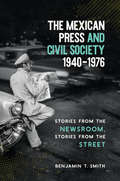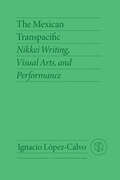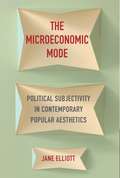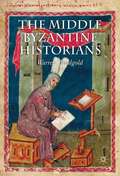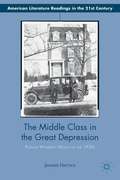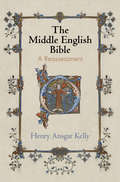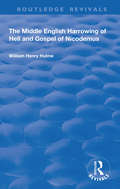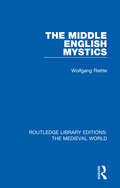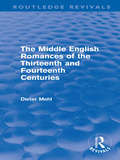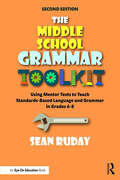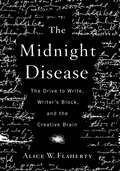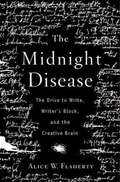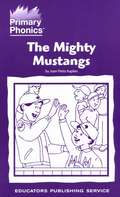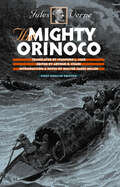- Table View
- List View
The Metanarrative of Suspicion in Late Twentieth-Century America (Literary Criticism and Cultural Theory)
by Sandra BaringerNarratives of suspicion and mistrust have escaped the boundaries of specific sites of discourse to constitue a metanarrative that pervades American culture. Through close reading of texts ranging from novels (Pynchon's Vineland, Silko's Almanac of the Dead, Pierce's The Turner Diaries) to prison literature, this book examines the ways in which narratives of suspicion are both constitutive--and symptomatic--of a metanarrative that pervades American culture.
The Metaphor Compass: Directions for Metaphor Research in Language, Cognition, Communication, and Creativity
by Marianna Bolognesi Ana Werkmann HorvatThe Metaphor Compass: Directions for Metaphor Research in Language, Cognition, Communication, and Creativity provides a roadmap to navigate the recent findings and cutting-edge research conducted around the world on metaphor, focusing on the following four themes: Metaphor and Linguistic Diversity, Metaphor and Cognition, Metaphor and Communication, and Metaphor and Creativity. The research presented in this book employs a variety of empirical methods, ranging from neuroimaging to corpus analyses and from behavioral experimentation to computational modeling. Divided into four parts, it offers an array of pedagogical material including activities at the ends of the chapters, to help the reader to consolidate the notions discussed in the chapter. This is a useful resource for students, researchers, and scholars of linguistics, communication, anthropology, psychology, and cognitive science looking to learn about figurative language and creativity.
The Metaphor of Celebrity
by Joel DeshayeThe Metaphor of Celebrity is an exploration of the significance of literary celebrity in Canadian poetry. It focuses on the lives and writing of four widely recognized authors who wrote about stardom - Leonard Cohen, Michael Ondaatje, Irving Layton, and Gwendolyn MacEwen - and the specific moments in Canadian history that affected the ways in which they were received by the broader public.Joel Deshaye elucidates the relationship between literary celebrity and metaphor in the identity crises of celebrities, who must try to balance their public and private selves in the face of considerable publicity. He also examines the ways in which celebrity in Canadian poetry developed in a unique way in light of the significant cultural events of the decades between 1950 and 1980, including the Massey Commission, the flourishing of Canadian publishing, and the considerable interest in poetry in the 1960s and 1970s, which was followed by a rapid fall from public grace, as poetry was overwhelmed by greater popular interest in Canadian novels.
The Metaphoric Structure of Paradise Lost
by Jackson I. CopeOriginally published in 1962. The rise of "metaphoric" criticism is a reaction against a previous critical preoccupation with psychology and time. Milton spatialized time, thoroughly mastering a metaphoric technique. The Metaphoric Structure of Paradise Lost, after discussing the influences that shaped Milton's aesthetic, systematically examines the structural components of Paradise Lost—light, darkness, and vertical movement—and finds that they imitate, metaphorically, the overall theme of the epic. To test further the implications of his hypothesis, Professor Cope turns to two unsettled points in Miltonic exegesis: Milton's muse and the dialogue in Heaven.
The Metaphysical Poets (Longman Medieval and Renaissance Library)
by David ReidThe Metaphysical Poets provides an introduction to the work of six strikingly various and original poets- Donne, Herbert, Crashaw, Vaughan, Marvell and Traherne. By closely examining how the poems work, the book aims to help readers at all stages of proficiency and knowledge to enjoy and critically appreciate the ways in which fantastic and elaborate styles may express private intensities. The emphasis is on the differences covered by the term 'Metaphysical' and on the rich and strange diversity of the poets' inner lives. The book examines the expressive forms of interiority, the characteristic inward turn of Metaphysical wit, and compares the wit of its six poets with the non-introspective wit of poets such as Cowley, the Cavaliers and the Augustans. The discussion of each poet is preceded by a 'Life' in which the biographical facts, personal, cultural and political, are treated with a view to illuminating the concerns of the poems.
The Metaverse: A Critical Assessment (SpringerBriefs in Ethics)
by Philip BreyThis book offers an extensive assessment of the nature and feasibility of the metaverse and is the first to critically examine its social and ethical implications. The metaverse is, in essence, an envisioned future merger of virtual and augmented reality (VR and AR) and the internet, enabling real-time immersive interaction and activities like work, play, socializing, and entertainment. Major tech companies like Meta, Microsoft, Apple and NVIDIA have been investing billions in metaverse technologies, with generative AI accelerating progress. This book examines how these efforts could culminate in the metaverse, exploring its potential forms, implications, and the social and ethical challenges it may pose—along with recommendations for responsible innovation. The book is aimed at stakeholders shaping the metaverse—developers, creators, investors, business leaders, and thought leaders in technologies like VR, AR, Web3, blockchain, and AI. It also serves scholars and students in applied ethics, the social sciences, and the humanities, including fields such as media studies, psychology, and law. General readers interested in the metaverse and emerging technologies will find it both accessible and engaging. Endorsements: "In this book, the talented and eloquent philosopher Philip Brey carefully explains the history and ideas behind the metaverse, and the prospects for its further development and adoption. That detailed information, meticulously presented, makes this a valuable read. But that is just the start. In later chapters, Brey just as skillfully describes the opportunities and vulnerabilities that a metaverse is likely to generate. These chapters are thorough, precise, and offer profound insights into our possible futures. Some of the possibilities are exciting. Others are frightening." –Keith W. Miller, University of Missouri–St. Louis.
The Method Works: Studies on Language Change in Honor of Don Ringe
by Joseph F. Eska Jean-François Mondon Olav Hackstein Ronald I. KimThis volume contains an introductory essay, the bibliography of Professor Ringe, and nineteen articles on various aspects of historical linguistics composed by current and former colleagues and students at the University of Pennsylvania and a select number of leading scholars in the field based at institutions such as Cornell University, Harvard University, Oxford University, Saarland University, University of Georgia, University of California at Los Angeles, University of Munich, and York University. The majority of contributions focus upon linguistic phylogenetics (the interrelationships among languages), Classical linguistics, and Germanic linguistics. Many of the contributions make contributions to theoretical, as well as historical, linguistics.
The Methods and Skills of History: A Practical Guide (Third Edition)
by Conal Furay Michael J. SalevourisThe Methods and Skills of History: A Practical Guide, is a dynamic text/workbook that combines theory with "hands on" practice, providing engaging essays, documents, and exercises designed to make history more meaningful and accessible to student readers--whether they are majoring in history, taking a history course as an elective, or simply reading history on their own--as well as strengthen their critical-thinking and communication skills.
The Methods of the Gernet Classicists: The Structuralists on Myth (Routledge Library Editions: Myth #2)
by Roland A. ChampagneThe Gernet Centre was founded as a place where the structural method could be applied to the classics. ‘Structuralists’ attribute the survival, origin and function of myths to common crosscultural factors they identify as ‘structures’. As this book, first published as The Structuralists on Myth in 1992 explains, these structures are bundles of information not obvious either to the narrator or to the listener. The bundles are collected features that reveal either the reasons for the survival of myths, or their origins, or their functions within their contexts. The structuralists consider themselves to have talents as the collectors from myths of these bundles of information.
The Mexican Crack Writers: History and Criticism (Literatures of the Americas)
by Héctor JaimesThis book provides a rich and cutting-edge analysis of one of the most prominent literary groups in Latin America: the Mexican Crack Writers. The first part explores the history of the group and its relation to the Latin American literary tradition, while the second part is devoted to the critical analysis of the works of each of the authors: Ricardo Chávez Castañeda, Ignacio Padilla, Pedro Ángel Palou, Eloy Urroz and Jorge Volpi. The volume is further enriched by the inclusion, in the appendix, of the two manifestos of the group: the Crack Manifesto and the Crack Postmanifesto (1996-2016). It will be of great interest to students and scholars focusing on contemporary Latin American literature.
The Mexican Novel in Times of Rupture: At the Intersection of Globalization and Postmodernism (Literatures of the Americas)
by Héctor JaimesThis book offers a close reading analysis of contemporary Mexican authors whose novels, in both form and content, are reshaped by the forces of globalization and postmodernism. Drawing on an interdisciplinary approach, the author examines the works of Jorge Volpi, Yuri Herrera, Guillermo Fadanelli, Eloy Urroz, Julián Herbert, Álvaro Enrigue, Valeria Luiselli, Pedro Ángel Palou, Guadalupe Nettel, Verónica Gerber Bicecci, and Mario Bellatin, exploring the themes of globalization, ethics, history, love, and literary forms. By addressing the critical intersections of these issues, the book makes a timely contribution to the study of contemporary Mexican literature in the context of a rapidly changing world.
The Mexican Press and Civil Society, 1940–1976: Stories from the Newsroom, Stories from the Street
by Benjamin T. SmithMexico today is one of the most dangerous places in the world to report the news, and Mexicans have taken to the street to defend freedom of expression. As Benjamin T. Smith demonstrates in this history of the press and civil society, the cycle of violent repression and protest over journalism is nothing new. He traces it back to the growth in newspaper production and reading publics between 1940 and 1976, when a national thirst for tabloids, crime sheets, and magazines reached far beyond the middle class.As Mexicans began to view local and national events through the prism of journalism, everyday politics changed radically. Even while lauding the liberty of the press, the state developed an arsenal of methods to control what was printed, including sophisticated spin and misdirection techniques, covert financial payments, and campaigns of threats, imprisonment, beatings, and even murder. The press was also pressured by media monopolists tacking between government demands and public expectations to maximize profits, and by coalitions of ordinary citizens demanding that local newspapers publicize stories of corruption, incompetence, and state violence. Since the Cold War, both in Mexico City and in the provinces, a robust radical journalism has posed challenges to government forces.
The Mexican Transpacific: Nikkei Writing, Visual Arts, and Performance (Critical Mexican Studies)
by Ignacio López-CalvoThe Mexican Transpacific considers the influence of a Japanese ethnic background or lack thereof in the cultural production of several twentieth- and twenty-first-century Mexican authors, performers, and visual artists. Despite Japanese Mexicans&’ unquestionable influence on Mexico&’s history and culture and the historical studies recently published on this Nikkei community, the study of its cultural production and therefore its self-definition has been, for the most part, overlooked. This book, a continuation of author Ignacio López-Calvo&’s previous research on cultural production by Latin American authors of Asian ancestry, focuses mostly on literature, theater, and visual arts produced by Japanese immigrants in Mexico and their descendants, rather than on the Japanese community as a mere object of study. With this interdisciplinary project, López-Calvo aims to bring to the fore this silenced community&’s voice and agency to historicize its own experience.
The Microeconomic Mode: Political Subjectivity in Contemporary Popular Aesthetics
by Jane ElliottFrom The Road to Game of Thrones, across works as seemingly different as Gone Girl and Saw, literature, film, and television have become obsessed with the intersection of survival and choice. When the trapped rock-climber hero of 127 Hours is confronted with self-amputation or death, it is only a particularly blunt example of an omnipresent set-up. In real-life settings or fantastical games, protagonists find themselves confronting extreme scenarios with life-or-death consequences, forced to make torturous either-or choices in stripped-down, brutally stark environments.Jane Elliott identifies and analyzes this new and distinctive aesthetic phenomenon, which she calls “the microeconomic mode.” Through close readings of its narratives, tropes, and concepts, she traces the implicit theoretical and political claims conveyed by this combination of abstraction and extremity. In the microeconomic mode, humans isolated from any forms of social organization operate within a mini-economy of costs and benefits, gains and losses, measured in the currency of life. Elliott reads the key concepts that emerge from this aesthetic—life-interest, sovereign capture, and binary life—in relation to biopolitics and natural law theory, becoming and the control society, and primitive accumulation in racial capitalism. The microeconomic mode interrogates the destruction of the liberal political subject, but what it leaves in its place is as disturbing as it is radically new. Going beyond the question of neoliberalism in literature, The Microeconomic Mode combines revelatory close readings of key literary and popular texts with significant theoretical interventions to identify how an aesthetics of choice has reshaped our contemporary understanding of what it means to be human.
The Middle Byzantine Historians
by Warren TreadgoldThis volume, which continues the same author's Early Byzantine Historians , is the first book to analyze the lives and works of all forty-three significant Byzantine historians from the seventh to the thirteenth century, including the authors of three of the world's greatest histories: Michael Psellus, Princess Anna Comnena, and Nicetas Choniates.
The Middle Class in the Great Depression
by Jennifer HaytockIn contrast to most studies of literature from the Great Depression which focus on representations of poverty, labor, and radicalism, this project analyzes popular representations of middle class life.
The Middle English Bible: A Reassessment (The Middle Ages Series)
by Henry Ansgar KellyIn the last quarter of the fourteenth century, the complete Old and New Testaments were translated from Latin into English, first very literally, and then revised into a more fluent, less Latinate style. This outstanding achievement, the Middle English Bible, is known by most modern scholars as the "Wycliffite" or "Lollard" Bible, attributing it to followers of the heretic John Wyclif. Prevailing scholarly opinion also holds that this Bible was condemned and banned by the archbishop of Canterbury, Thomas Arundel, at the Council of Oxford in 1407, even though it continued to be copied at a great rate. Indeed, Henry Ansgar Kelly notes, it was the most popular work in English of the Middle Ages and was frequently consulted for help in understanding Scripture readings at Sunday Mass.In The Middle English Bible: A Reassessment, Kelly finds the bases for the Wycliffite origins of the Middle English Bible to be mostly illusory. While there were attempts by the Lollard movement to appropriate or coopt it after the fact, the translation project, which appears to have originated at the University of Oxford, was wholly orthodox. Further, the 1407 Council did not ban translations but instead mandated that they be approved by a local bishop. It was only in the early sixteenth century, in the years before the Reformation, that English translations of the Bible would be banned.
The Middle English Harrowing of Hell and Gospel of Nicodemus (Routledge Revivals)
by William Henry HulmeFirst published in 1907, the publication of these Middle-English texts aimed to make the dramatic Harrowing of Hell and Gospel of Nicodemus easily accessible to students of English literature. Edited together using all known manuscripts, the volume includes the texts of the Harrowing of Hell and the Gospel of Nicodemus along with an extensive scholarly introduction on both texts. The Digby, Harley and Auchinleck manuscripts of the Harrowing are printed in three parallel columns to allow for fuller, comparative understanding, at once succinct and comprehensive. The Gospel is reproduced similarly with its Galba, Harley and Sion manuscripts along with an additional manuscript. Explanatory notes and glosses have been omitted owing to inclusion in a separate publication.
The Middle English Mystics (Routledge Library Editions: The Medieval World #41)
by Wolfgang RiehleOriginally published as an English translation in 1981, The Middle English Mystics is a crucial contribution to the study of the literature of English mysticism. This book surveys and analyses the language of metaphor in the writings of such mystics as Richard Rolle, Walter Hilton, Julian of Norwich, and in such anonymous works as The Cloud of Unknowing and the Ancrene Wisse. The main emphasis of this comparative and stylistic study is not theological but rather the means by which theological concepts are communicated through language. The book sets the English mystics in perspective by establishing their place in the European mystical movement of the Middle Ages. It shows how intricate the relationship between English, and continental mysticism really is. The book suggests that there is clear links between English and German female mysticism, yet the mysticism is in the main due not so much to specific influences as to the common background of Christian theology and mysticism.
The Middle English Romances of the Thirteenth and Fourteenth Centuries (Routledge Revivals)
by Dieter MehlFirst published in English in 1968, this book provides a critical guide to the wide field of the Middle English Romances and gives a helpful survey of the contemporary state of scholarship. Dr Mehl traces the development of Middle English Romances from thee thirteenth to the end of the fourteenth century, and interprets a number of these romances. The emphasis is literary, on their form and dominant themes rather than source-material or language.
The Middle School Grammar Toolkit: Using Mentor Texts to Teach Standards-Based Language and Grammar in Grades 6–8
by Sean RudayTeaching grammar can be overwhelming and is often an overlooked part of effective instruction. The Middle School Grammar Toolkit to the rescue! Now in its second edition, this comprehensive guide makes grammar instruction fun and meaningful. You will learn how to: Teach grammar in a practical and applicable way by presenting each grammar rule as a useful writing tool for students. Use mentor texts—excerpts from great literature—to help students understand grammar in action. Promote metacognition along the way, so that students become responsible for their own learning. Implement innovative instructional strategies and tools aligned with Common Core and other state standards. Throughout the book, you’ll find step-by-step recommendations for teaching grammatical concepts, such as understanding intensive pronouns, choosing language that expresses ideas precisely, forming verbs in different moods, and maintaining consistency in style and tone, and much, much more. Organized to help students meet the Common Core State Standards and other state language standards for Grades 6–8, the book includes tips addressing teaching for each of these grades, classroom snapshots that show you the tools in action, and specific instructional recommendations to engage students. New! The second edition features revised classroom snapshots and exemplars to showcase successful practices, and new flowcharts to visually represent instructional recommendations. The expanded, free annotated bibliography is updated to include contemporary, high-quality young adult literature and gives examples of key grammatical concepts found in each work. These resources are available as Supplemental Downloads on our website.
The Midnight Disease: The Drive to Write, Writer's Block, and the Creative Brain
by Alice W. Flaherty&“An original, fascinating, and beautifully written reckoning . . . of that great human passion: to write.&”—Kay Redfield Jamison, national bestselling author of An Unquiet Mind Why is it that some writers struggle for months to come up with the perfect sentence or phrase while others, hunched over a keyboard deep into the night, seem unable to stop writing? In The Midnight Disease, neurologist Alice W. Flaherty explores the mysteries of literary creativity: the drive to write, what sparks it, and what extinguishes it. She draws on intriguing examples from medical case studies and from the lives of writers, from Franz Kafka to Anne Lamott, from Sylvia Plath to Stephen King. Flaherty, who herself has grappled with episodes of compulsive writing and block, also offers a compelling personal account of her own experiences with these conditions. &“[Flaherty] is the real thing . . . and her writing magically transforms her own tragedies into something strange and whimsical almost, almost funny.&”—The Washington Post &“This is interesting, heated stuff.&”—San Francisco Chronicle &“Brilliant . . . [a] precious jewel of a book . . . that sparkles with some fresh insight or intriguing fact on practically every page.&”—Seattle Post-Intelligencer &“Flaherty mixes memoir, meditation, compendium and scholarly reportage in an odd but absorbing look at the neurological basis of writing and its pathologies . . . Writers will delight in the way information and lore are interspersed.&”—Publishers Weekly
The Midnight Disease: The Drive to Write, Writer's Block, and the Creative Brain
by Alice Weaver FlahertyNeurologist Flaherty (Massachusetts General Hospital and Harvard Medical School) explains the psychological and neuroscientific knowledge about the process of writing for a lay audience. She discusses the temporal lobe's role in "abnormal hypergraphia," an increased desire to write. She then explores psychological and neurological explanations for writer's block. The roles of the cerebral cortex in writing ability, the limbic system in the drive to communication, and the temporal lob in metaphorical thinking are examined in subsequent chapters. Annotation ©2004 Book News, Inc. , Portland, OR (booknews. com)
The Mighty Orinoco (Early Classics of Science Fiction)
by Jules VerneFirst English edition of a classic Verne adventure, with a unique feminist twist. Jules Verne (1828-1905) was the first author to popularize the literary genre of science fiction. Written in 1898 and part of the author's famous series Voyages Extraordinaires, The Mighty Orinoco tells the story of a young man's search for his father along the then-uncharted Orinoco River of Venezuela. The text contains all the ingredients of a classic Verne scientific-adventure tale: exploration and discovery, humor and drama, dastardly villains and intrepid heroes, and a host of near-fatal encounters with crocodiles, jungle fever, Indians and outlaws — all set in a wonderfully exotic locale. The Mighty Orinoco also includes a unique twist that will appeal to feminists — readers will need to discover it for themselves. This Wesleyan edition features notes, and a critical introduction by renowned Verne scholar Walter James Miller, as well as reproductions of the illustrations from the original French edition. CONTRIBUTORS: Walter James Miller, Stanford Luce, Arthur B. Evans.
